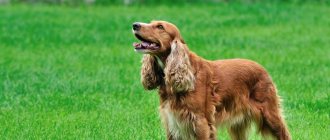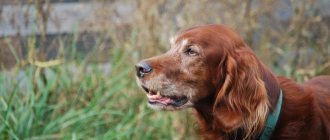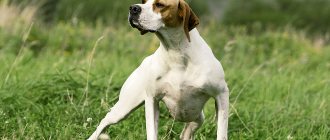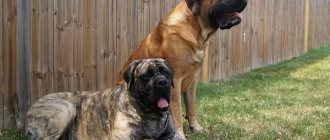A type of special purpose hunting pointing dog with long hair is called a setter. The name of this group of dogs comes from the English word “crouching”, due to its original manner of working. They are designed for accurate and quick search of game over large areas.
There are four breeds in total: English, Irish, Irish Red and White and Scottish Setters. They differ from each other not only in appearance, but also in behavior both in everyday life and while hunting. Let's look at what each setter dog breed is.
Breed characteristics
| Short description | |
| Origin: | England |
| Conditions of detention: | Private house, apartment |
| Purpose: | Hunting dogs, companion dogs |
| Color: | Mottled, white-black or yellow-brown |
| Wool length: | Long |
| Adult dog size: | Height of females – 61–65 cm, males – 65–69 cm, recommended weight – 20–30 kg |
| Average life expectancy: | 10-14 years |
| Walk: | Needed, once a day or more |
| Physical activity needs: | Medium, walks at least 1 hour |
| Fédération Cynologique Internationale (FIC) classification: | Group 7: pointing dogs; Section 2 Island Cops; Subsection 2.2 setters |
| Puppy price: | On average 25,000–30,000 rubles. |
Photo gallery
Photo 1. Setter resting in the forest
Photo 2. Three setters running
Photo 3. Baby chewing on a feather
Photo 4. Dog close-up
Photo 5. Well-groomed and beautiful dog
Photo 6. Ready for exhibition
Origin story
It is perhaps impossible to find an English Setter dog owner who does not consider his pet the most elegant and friendly dog. These animals have long been considered real aristocrats in the “dog world” and are known for their unsurpassed hunting talents.
The ancestors of modern English setters lived in Europe back in the Middle Ages. Their history can be traced back to the 15th century. It is believed that these were spaniels, belonging to the oldest group of hunting dogs.
One of the subspecies that existed at that time was the setting spaniel. The animals got their name because of their unusual method of hunting. They would sneak up on their prey and take a special stance.
Over time, setting spaniels began to be crossed with representatives of other hunting breeds. It is assumed that these were Spanish pointers, or bloodhounds, or some other breeds that have not been established for certain. As a result, stronger and more robust animals emerged. They can be seen in paintings and illustrations created about 400 years ago and more recently.
At that time, the most important role was given to the working qualities of dogs. In terms of appearance, they could be completely different. Edward Laverack was the first to standardize the English Setter breed in the 19th century . And in 1859, its representatives appeared at a dog show. The popularity of the breed began to grow and reached the New World. But, oddly enough, it also played against hunting qualities. A large number of show dogs appeared, not adapted to work, with dulled hunting instincts. They became companions.
By the end of the twentieth century, the popularity of English setters declined, but the number of animals remained stable.
Varieties
English Setters have two varieties, which resulted from the breeding of the breed by two different hunters. Most modern representatives of the breed belong to the Setter-Laverak species. The dogs have a strong build and floppy ears. Outwardly, they resemble spaniels. The animals are purebred English setters.
Representatives of the Setter-Llewellyn variety are larger than their counterparts. They are characterized by a tricolor color. Due to the fact that during their breeding much attention was paid to the exterior of the pets, they often take part in exhibitions, demonstrating an amazing appearance. The dogs cannot be called completely purebred, since Llewellyn crossed them with representatives of other breeds in order to achieve an improved exterior.
The FCI standard provides characteristics for both varieties. Representatives of species have equal rights to take part in competitions, exhibitions and hunting.
Distinctive features
The English Setter is a rather large pointing dog. Thanks to a combination of light weight, strength and endurance, it can reach high speeds over short distances and can withstand long runs. The officially recognized and permitted position for the breed is the recumbent position.
The English Setter can be identified by the following distinctive features:
- The body is squat, strong, dry. The body is of medium length, with a well-developed muscle corset, a voluminous chest and a wide loin. The abdomen is moderately retracted. The back is straight and short.
- The head is oval, raised high, slightly extended forward, with a well-defined occipital part, a sharp transition from the forehead to the muzzle, elongated. The jaw has a scissor bite.
- The neck is long, dry, muscular. A short and thick neck is considered unacceptable.
- The eyes are expressive, shallow-set, round, with protruding brow ridges. The color of the iris ranges from coffee to dark brown, the darker the better.
- The ears are soft, hanging, of medium length. They are located parallel to the eye line and adjacent to the cheekbones. Their length is such that the ear extended forward reaches the tip of the nose.
- The front legs are straight, set parallel to each other. There is long hair between the toes.
- The hind legs are long and muscular.
- The tail is straight, saber-shaped, continuing the line of the back. It is held vertically, at the level of the back. The lower part is decorated with beautifully hanging down fur.
- The coat on the body and tail is thick and long. The coat is smooth, silky, with a slight shine. The ears, chest, back of the paws and tail are especially thick with fur.
- The color is mottled and comes in two varieties: white-black and yellow-brown. There is no pure color; two or three colors are possible. The value of a dog depends on the size of the spots (specks): the smaller they are, the better. Preference is given to individuals with uniformly colored fur and speckled paws.
Nutrition
The English Setter's food should contain a lot of micro and macroelements, vitamin supplements, and calcium. This is important for the normal development and growth of the puppy. In a natural menu, it is important to adhere to the following products:
- sour milk;
- sea fish;
- nuts;
- vegetables/greens;
- eggs;
- offal;
- sauerkraut;
- fresh fruits;
- cereals: rice, buckwheat, wheat, oatmeal, arnautka;
- lean meat.
The meat component must be frozen first to avoid infecting your pet with helminths. Feed vegetables and fruits with a small addition of sunflower oil - this way they are better absorbed. To preserve more useful components, it is advisable not to cook vegetables. Store-bought semi-finished products, yeast dough and all flour products, sweets, potatoes, grapes and citrus fruits are prohibited.
Photo of an adult dog
Photos of puppies
Features of character and behavior
Despite the fact that the original purpose of English Setters is hunting, they are quite family dogs. You can even have them in houses where kids grow up.
Advantages
- Setters are friendly and non-conflict animals that can get along not only with all family members, but also with most pets. The only exceptions may be birds and other small pets. Dogs often show hunting interest in them.
- Setters are unobtrusive and do not fight for their own territory. All they need is a little space at their owner's feet. Their loud barking can be heard infrequently, mainly when meeting one of the family members. An expression of dissatisfaction is usually grumbling.
- Dogs are very sociable and can quickly get used to a stranger, showing curiosity rather than aggression towards him. But friendliness and trust in a person in the broad sense of the word does not cancel the devotion to the only owner, which the dog retains for the rest of his life.
- Since English Setters are natural hunters, work makes them forget about sleep, hunger and fatigue . And such a quality as the sense of smell is highly valued by hunters and rescuers. In everyday life, animals require active activities. They love to play, move, and can accompany their owner on hikes, travels, and jogging.
- An interesting feature of English setters is their unusual display of good mood . While in this state, dogs begin to literally drool, just as St. Bernards do. However, this minor drawback is more than compensated by the affection and devotion of the animals.
Flaws
Those who are thinking about purchasing an English Setter puppy need to understand that the “puppy age” of this breed lasts for about two years . Only after reaching this age do dogs begin to mature. Until this moment, owners must be prepared for the fact that the pet will not deny itself the pleasure of stealing something tasty from the table or chewing on shoes, pencils or any objects that attract its attention.
Application
Initially, the animals were used as gun dogs. But today they are more often taken as companions.
If you need a friend, not a hunter, you should take a show line dog. She doesn't need to run for 12 hours to burn off energy. She is calmer, looks more beautiful, and can sublimate hunting with stances on pigeons and other urban birds.
If you want to hunt game, then you need to buy a dog from hunter breeders. They raise excellent working dogs.
Due to the lack of aggression, there are no watchmen or guards from pets. They would rather kiss a robber than bark at him.
Care and maintenance
- In everyday life, dogs demonstrate their unpretentiousness . Important requirements for owners are regular care of the setter's silky coat, ears and teeth. Their coat needs to be trimmed from time to time along the neck, under the ears, and around the paw pads.
- The drooping ears of representatives of this breed are a separate concern for owners . You should take care of them constantly to prevent ear diseases. Their main causes are mites, as well as sulfur. If they are not removed, there is a risk of developing otitis media.
- English Setters need to have their teeth brushed to remove tartar . This can be done with special brushes, or by giving the animal sugar bones.
Nutrition
The diet can be based on both natural products and special balanced feed of good quality. It is useful to include lean meats, vegetables, fruits, ocean or sea fish, and sometimes honey .
Dogs love porridges, for example, buckwheat, rice, millet . They can be cooked in meat broth or in water with the addition of vegetable oil. To maintain ideal coat condition, you can give your pet 20 grams of butter with bread every day. Access to drinking water must be available around the clock.
It is strictly forbidden to feed setters with pork, salt and sugar, potatoes, sweets, and flour products.
- The diet should be regular.
- For adults, 2 feedings are enough.
- Puppies up to 2–3 months of age need 4–5 meals a day ; by the age of one year they switch to 3 meals. Their menu includes milk porridges, fermented milk products (ryazhenka or kefir), meat, vegetables, cereals, and cottage cheese. Puppies should eat about 300–400 grams of meat products (animals under 6 months old - 150 grams).
Health
Caring for the health of animals consists of standard preventive procedures (vaccination and deworming), as well as regular examinations after walks to detect ticks.
Vaccinations
Each animal must be vaccinated against the following diseases:
- Plague;
- Leptospirosis;
- Rabies;
- Parvovirus;
- Hepatitis;
- Trichophytosis;
- Coronavirus.
- The first vaccine is administered to puppies at the age of 2 months. Within 2 weeks after the procedure, immunity develops, which may be accompanied by weakness, fever, and diarrhea.
- The second vaccination is given after 3 weeks . It is easier to tolerate.
- Upon reaching the age of one year and every 12 months, a complex vaccine is prescribed. The composition and date of each vaccination is entered in the animal’s passport.
Six-month-old animals are given a complex vaccine and anti-rabies drug. This is done only after the dog’s teeth have changed.
Diseases
The breed has excellent health. The average life expectancy of its representatives is 10 – 14 years. But English setters also have diseases that are characteristic of them:
- Hip dysplasia is a defect that can cause pain, lameness and the development of arthritis;
- Deafness can be congenital or acquired;
- Progressive retinal atrophy is typical for older animals and can lead to blindness;
- Food and skin allergies ;
- Hypothyroidism is a disease of the thyroid gland that can provoke disturbances in the psychological behavior of a dog;
- Epilepsy is a disorder that occurs in animals between the ages of 2 and 5 years.
Walk
The English Setter is a lively and active dog. She needs long walks, this is explained by her natural hunting instinct.
- You need to walk your English Setter at least once a day.
- After going for a walk with the dog, the owner should not rush home.
- The animal should be allowed to run for at least an hour, so that it feels a little tired.
- For small puppies, the duration of the walk can be reduced to 10 minutes. This time is enough to throw out the accumulated energy, otherwise walking will be excessively tiring for them.
Grooming
The long, silky coat of English Setters requires care:
- Puppies need to be brushed every day using a massage brush.
- Shedding fur should be brushed regularly.
- The coat should be brushed 1-2 times a week. After this procedure, the dog can be wiped with a damp towel, once in the direction of hair growth, once against the growth. This method of caring for the coat allows you to do without frequent washing of the animal.
From time to time, you can resort to trimming to remove too long and dying hairs. Show dogs require grooming from experts.
Irish Setter
The red color of this dog's coat, its independent character, and nobility speaks about its Irish origin. Flame on four legs, which is absolutely devoid of aggression, is always playful and cheerful - this is an Irish setter, a description of the breed is presented below, it is she who is depicted on packs of Chappi food.
Description of the breed
A dog with a harmonious build and medium size, dry constitution. The male reaches a height of up to 66 cm, and the female reaches up to 63. Weight can vary from 25 to 34 kg, depending on the height and gender of the dog. The head is long, with pronounced brow ridges. The ears are hanging, rounded, medium long and close-fitting.
The eyes are oval-shaped, slightly slanted. The nose is dark, with widened nostrils, which allow the Irishman to have an ideal sense of smell.
The Irish Setter is a breed of dog that has a very energetic character, sociable and kind, playful and sociable. She will be able to make friends with any pet you have, especially if she has known him since puppyhood. Looking for a family dog - the Irishman will be an ideal option. But a dog cannot live without hunting.
Care and maintenance
The Irish Setter dog is an animal for living in the house; it can hardly be imagined in a kennel on a leash or in an enclosure. But you will have to groom your long hair daily. This is not so difficult - comb it so that tangles do not form, and wash the dog as needed, but not often, because a special fat is formed on the coat, which protects the hair. The Irish Setter dog simply loves to swim, unlike the English one.
Like all setters, the Irishman requires special care for his ears to prevent ear infections.
This dog has enviable health, but the Irish Setter breed is often susceptible to the following diseases:
- allergic dermatitis due to high skin sensitivity;
- melanoma;
- enlargement of the esophagus (most often congenital);
- volvulus;
- problems with thyroid hormones;
- bone cancer;
- epilepsy.
Education and training
You need to train a dog of this breed regularly, but without raising your voice. The training is not very intensive, but once it is fixed, it will remain in his memory forever. Irish Setters are very moody and independent in behavior. That is why it is impossible to demand constancy from him.
Hunting with an Irish Setter
Passion and ease of control - these two words characterize the Irish Setter when hunting. He is tireless, but with prolonged fruitless walking he quickly loses his excitement. It is suitable for searching for game in already explored places; English is better suited for reconnaissance.
Mating
The best age for the first mating for females and males is 2 years. Until this time, it is not recommended to breed males; this will not improve the health of the future offspring.
The couples meet on neutral territory so that the animals can run around. Before mating, active walking is required. Feeding, on the contrary, is undesirable. Mating is carried out on the territory of the dog. The duration of pregnancy is from 58 to 65 days . There are an average of 6 puppies in a litter.
Key points in training
- English Setters are intelligent, highly trainable dogs that enjoy being exercised . You can start them from a very early age. Puppies quickly learn commands, especially if they receive their favorite treats as rewards.
- Representatives of the breed rarely demonstrate disobedience. In such cases, they need to be punished. To do this, just raise your voice and under no circumstances hit the animal.
- Setters generally do not take as much time to train as other dog breeds . The “English” master many commands on the fly and begin to carry them out strictly at the request of the owner.
Read about how to properly train a dog in the article: “Training a puppy: effective methods from dog handlers, learning commands at home.”
Interesting Facts
The English Setter was the most common breed among the Russian nobility in the 18th and 19th centuries. The history of the existence of the dog species contains several fascinating facts about animals:
- representatives of the upper classes would give up a village of serfs for one healthy setter;
- Leo Tolstoy had a pet of this breed, which became the prototype of Laski in the novel “Anna Karenina”;
- dogs were popular with many Russian emperors, among them Nicholas II;
- one of the representatives of the breed was filmed in the film “White Bim Black Ear” as a Scottish setter with defects in appearance.
How to choose a puppy
It is best to buy a puppy of this breed when he is 3-4 months old. By this age, the animal gains strength and becomes strong. When choosing a pet, you should examine all the babies from the litter and pay attention to the most balanced dog . However, she should not be too slow, aggressive during play, or timid.
The appearance of the animal also plays an important role. It is necessary to choose an animal with a uniform color, without sores on the skin, with strong paws, clean eyes of a dark color.
An English Setter puppy is the ideal choice for a person who dreams of a balanced, intelligent, but at the same time playful and good-natured dog.
5 / 5 ( 1 voice )
Upbringing
English setters are dogs of one owner. From the first day the puppy is in the house, one person should take care and feed it.
Setters almost never do any harm. Chewed furniture, torn curtains and uprooted flowers - this is not about them. But they need clear rules - if dogs are not allowed to do something, then forever - and vice versa.
Pets are obedient and easy to train. But they are often distracted by sounds and smells. Some animals are stubborn and may not follow commands.
Training is presented in the form of a game or imitation of hunting. No rudeness, monotonous repetition of commands or strict demands. Only affection and encouragement. And for punishment, a strict tone is enough.
The description of the breed says that English pointers consider themselves friends of man, and behave on an equal footing with their owner. They are more likely to respond to the phrase “Come here” than to the command “Come to me.”











